The Ultimate Gluten-Free Sugar Cookie Recipe: Soft, Buttery & Easy to Make for Any Occasion
Discover the ultimate recipe for the best **Gluten-Free Sugar Cookies** you’ll ever taste! These delightful cookies are incredibly tender, richly buttery, delightfully soft, and perfectly sweet—all without a trace of gluten. Whether you’re celebrating Christmas, Valentine’s Day, Halloween, or simply craving a classic treat, these cookies are a fantastic choice. Gather your favorite cookie cutters and prepare to create beautiful, delicious, and allergy-friendly confections that everyone will adore.
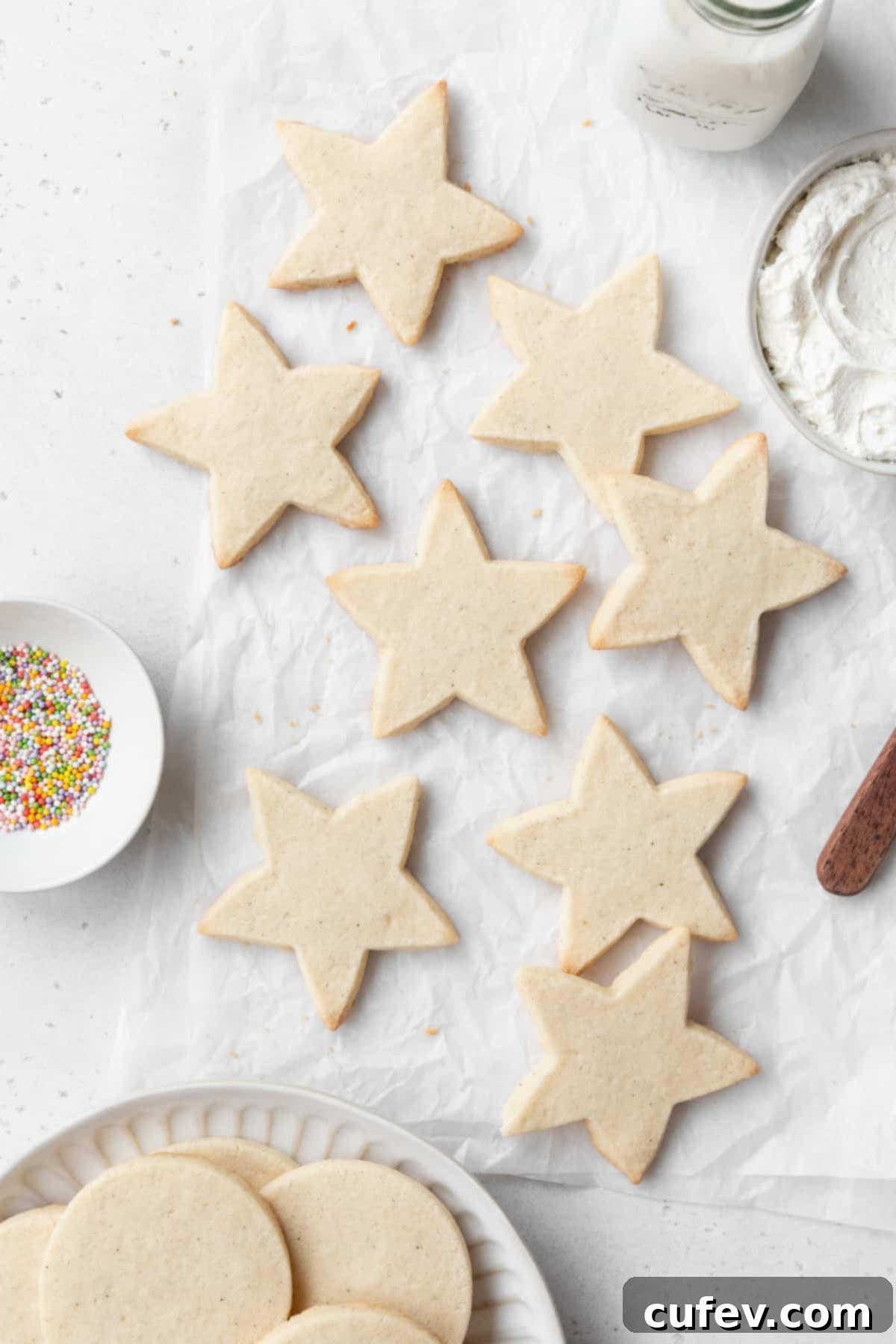
Essential Ingredients for Perfect GF Sugar Cookies
Crafting delicious gluten-free sugar cookies starts with high-quality ingredients, most of which are readily available at your local grocery store. Here’s a closer look at what you’ll need to create these tender, buttery treats:
- Gluten-Free 1-to-1 Flour Blend – This is the cornerstone of our gluten-free sugar cookie recipe. A high-quality 1-to-1 blend, such as Bob’s Red Mill 1-to-1 baking flour, is specifically formulated to mimic the properties of all-purpose wheat flour, making it ideal for baking. These blends typically include a mix of gluten-free flours (like rice flour, sorghum flour, or tapioca starch) and often contain xanthan gum, which provides structure and elasticity usually found in gluten. This means you won’t need to add any extra xanthan gum or other binders, simplifying the baking process considerably while ensuring a wonderfully soft and tender cookie texture.
- Almond Flour – Adding almond flour to this recipe contributes a delicate, nutty flavor and a desirable moist, tender crumb to the cookies. It helps achieve that perfect balance of softness and richness. If you have a nut allergy or prefer a nut-free option, you can easily substitute the almond flour with an equal amount of your chosen gluten-free 1-to-1 flour blend. This adjustment ensures everyone can enjoy these fantastic cookies.
- Butter – Unsalted butter is generally preferred in baking as it gives you complete control over the salt content in your recipe. However, if you only have salted butter on hand, you can use it; just be mindful to slightly reduce any added salt in the recipe. For those seeking a dairy-free option, high-quality vegan butter sticks work beautifully. When selecting vegan butter, ensure it contains approximately 8g of fat per 2 teaspoons (or 10g) of butter, as this fat content is crucial for the cookie’s texture and spread. Remember to use softened butter for optimal creaming with sugar, which creates a light and fluffy base.
- Milk – Just one tablespoon of milk, whether dairy or plant-based (such as almond milk or oat milk), is all it takes to enhance the moisture content of these cookies. This small addition is key to achieving that perfectly soft, tender, and melt-in-your-mouth texture that makes sugar cookies so irresistible.
- Vanilla Extract – For the most exquisite flavor profile, opt for pure vanilla extract or a vanilla bean paste. The rich, aromatic notes of good vanilla are essential for classic sugar cookies, complementing the buttery sweetness and adding depth to every bite.
- Granulated Sugar – This is what gives our cookies their signature sweetness and helps achieve their crisp yet tender edges. Granulated sugar provides the classic sugar cookie flavor and texture that we all know and love. While other sugars might be used, granulated sugar ensures the traditional look and taste.
- Fine Salt – A pinch of fine salt, as specified in the recipe card, is crucial for balancing the sweetness and enhancing all the other flavors in the cookie dough. It prevents the cookies from tasting overly sweet and brings out the richness of the butter and vanilla.

Baking Perfection: How to Make Irresistible Gluten-Free Sugar Cookies
You’ll be delighted to discover just how straightforward this gluten-free sugar cookie recipe is! The process is designed for ease and enjoyment, yielding perfect results every time. Follow these simple steps to create your batch of tender, buttery, and beautifully shaped cookies:
Step 1: Prepare Your Dry Ingredients. In a medium-sized mixing bowl, thoroughly whisk together the gluten-free 1-to-1 flour blend, almond flour, and fine salt. Whisking ensures that all the dry ingredients are evenly distributed, preventing pockets of unmixed flour or salt, which is crucial for a consistent cookie texture and flavor. Set this mixture aside.
Step 2: Cream Butter and Sugar. In a separate large bowl, or the bowl of a stand mixer equipped with a paddle attachment, add your softened butter and granulated sugar. Beat them together on medium speed until the mixture becomes light, fluffy, and noticeably creamy. This usually takes about 3 minutes. The creaming process incorporates air into the butter and sugar, which contributes significantly to the cookies’ light texture. Be sure to stop and scrape down the sides and bottom of the bowl with a rubber spatula halfway through to ensure everything is evenly combined. Once creamy, add the tablespoon of milk and the vanilla extract, then beat again until these liquid ingredients are fully incorporated and the mixture is smooth.
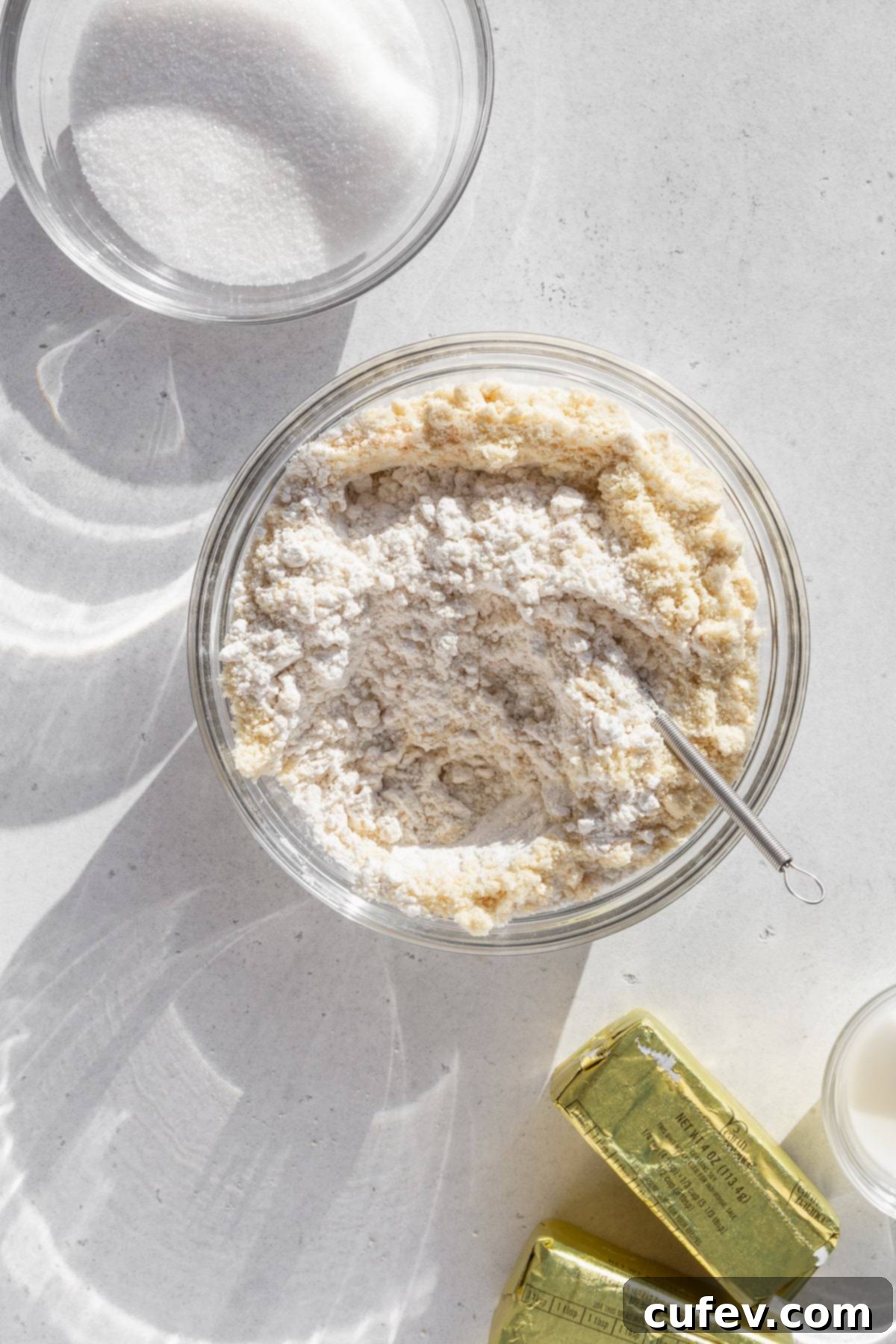
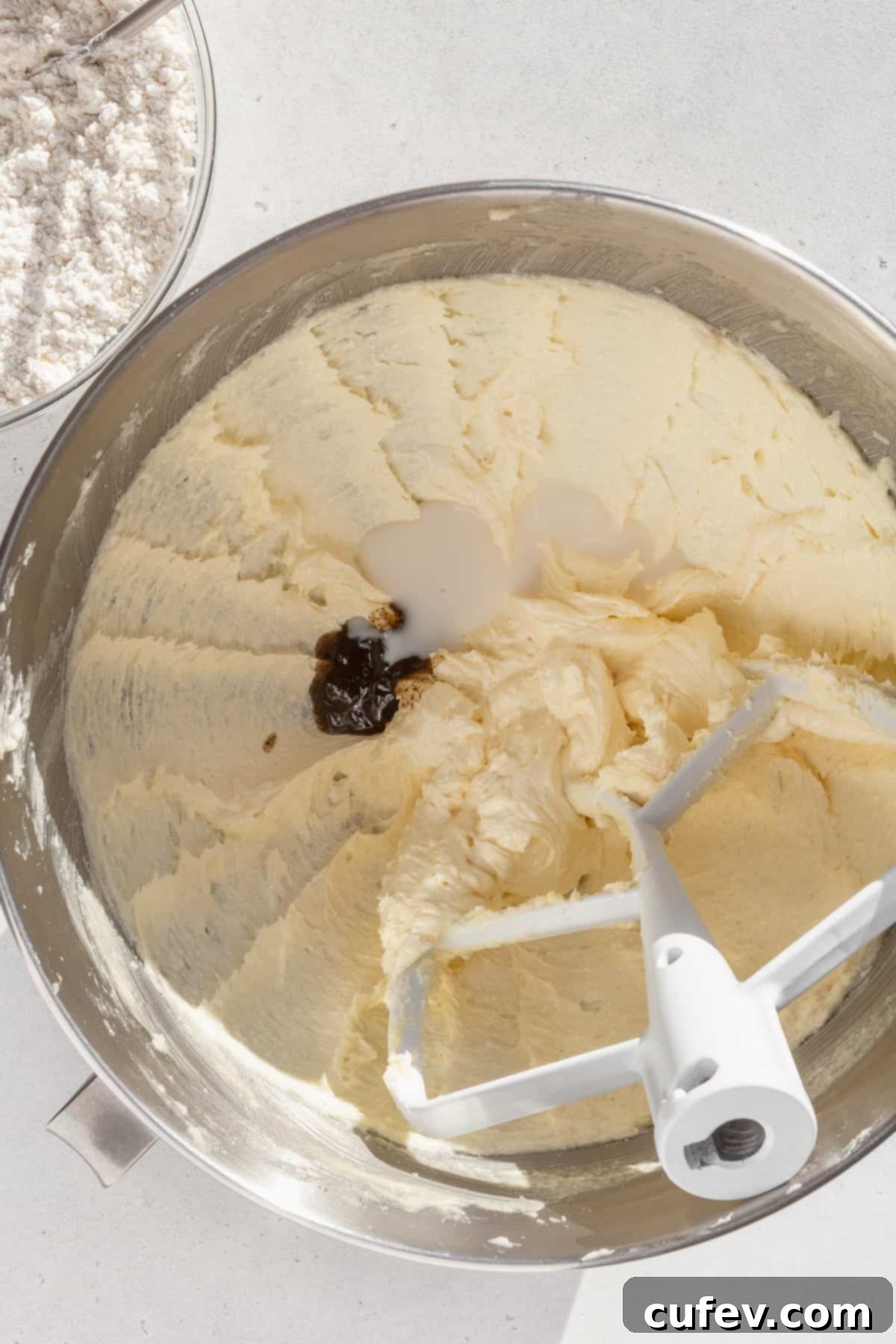
Step 3: Combine Wet and Dry Ingredients. Scrape down the bowl of your wet ingredients one more time to ensure no butter or sugar is stuck to the bottom. Gradually add the whisked flour mixture to the butter mixture. Mix on low speed until just combined, ensuring there are no visible streaks of dry flour remaining. It’s important not to overmix the dough at this stage, as overmixing can lead to tougher cookies.
Step 4: Rest the Cookie Dough. For truly exceptional gluten-free sugar cookies, this step is non-negotiable! Scrape the bowl one last time to confirm all ingredients are incorporated and no hidden pockets of flour remain. Cover the bowl tightly with plastic wrap and allow the dough to rest on the counter at room temperature for a full 30 minutes. This resting period is critical as it gives the gluten-free flour ample time to fully hydrate, preventing dry or gritty cookies and ensuring a tender, smooth dough that is much easier to roll out and yields a superior finished texture.
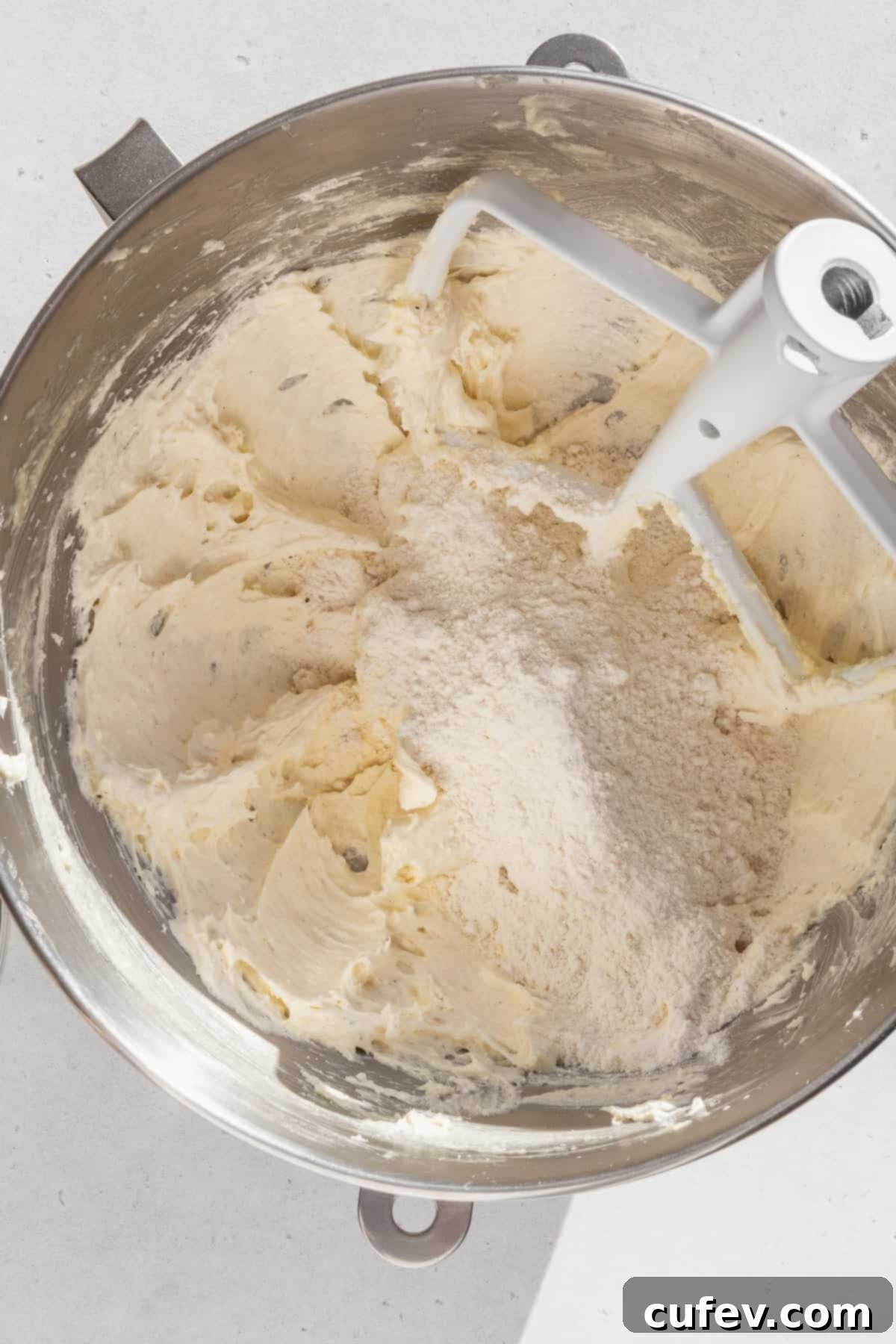
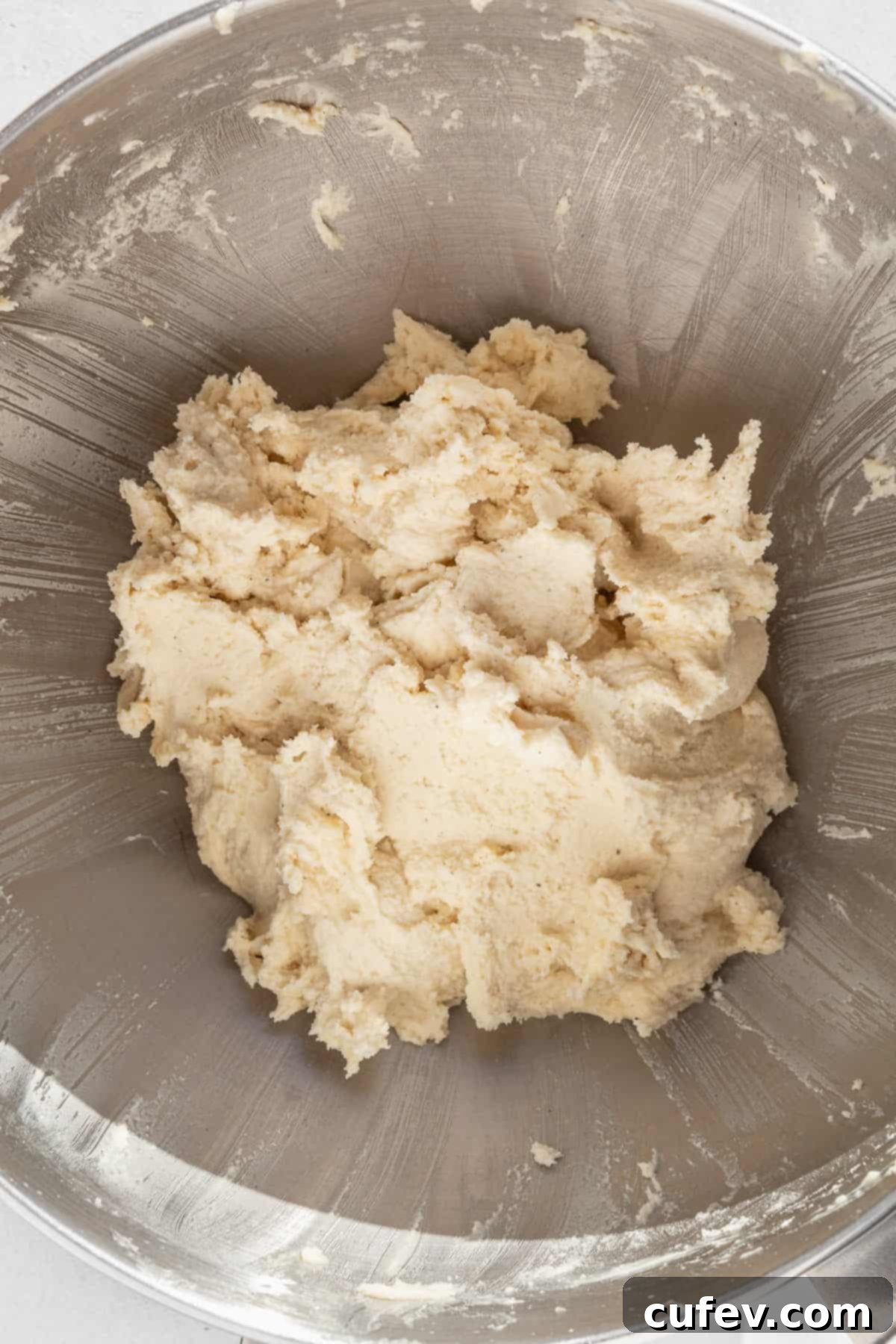
Step 5: Roll and Chill the Dough. Turn the rested cookie dough out onto a large piece of parchment paper. Place another sheet of parchment paper on top, then roll the dough evenly between the two sheets to a thickness of approximately ¼ inch (½ cm). Rolling between parchment paper prevents sticking and makes transfer easy. Once rolled, place the entire sheet of parchment paper with the dough into the refrigerator to chill while you proceed with the next steps. Chilling the dough firm it up, making it much easier to cut into shapes and preventing excessive spreading during baking.
Step 6: Preheat Oven and Prepare Baking Sheets. Preheat your oven to 375°F (190°C). While the oven is heating, line a baking sheet (or several, if you have them) with fresh parchment paper. This ensures even baking and prevents the cookies from sticking, making for easy removal and cleanup.
Step 7: Cut Out Cookie Shapes. Retrieve the chilled, rolled-out cookie dough from the refrigerator. Using your favorite cookie cutters – whether festive shapes for holidays or classic rounds – cut out as many cookies as possible from the dough. Work efficiently to keep the dough cold. If the dough becomes too soft to work with, simply pop it back into the refrigerator for a few minutes to firm up again.
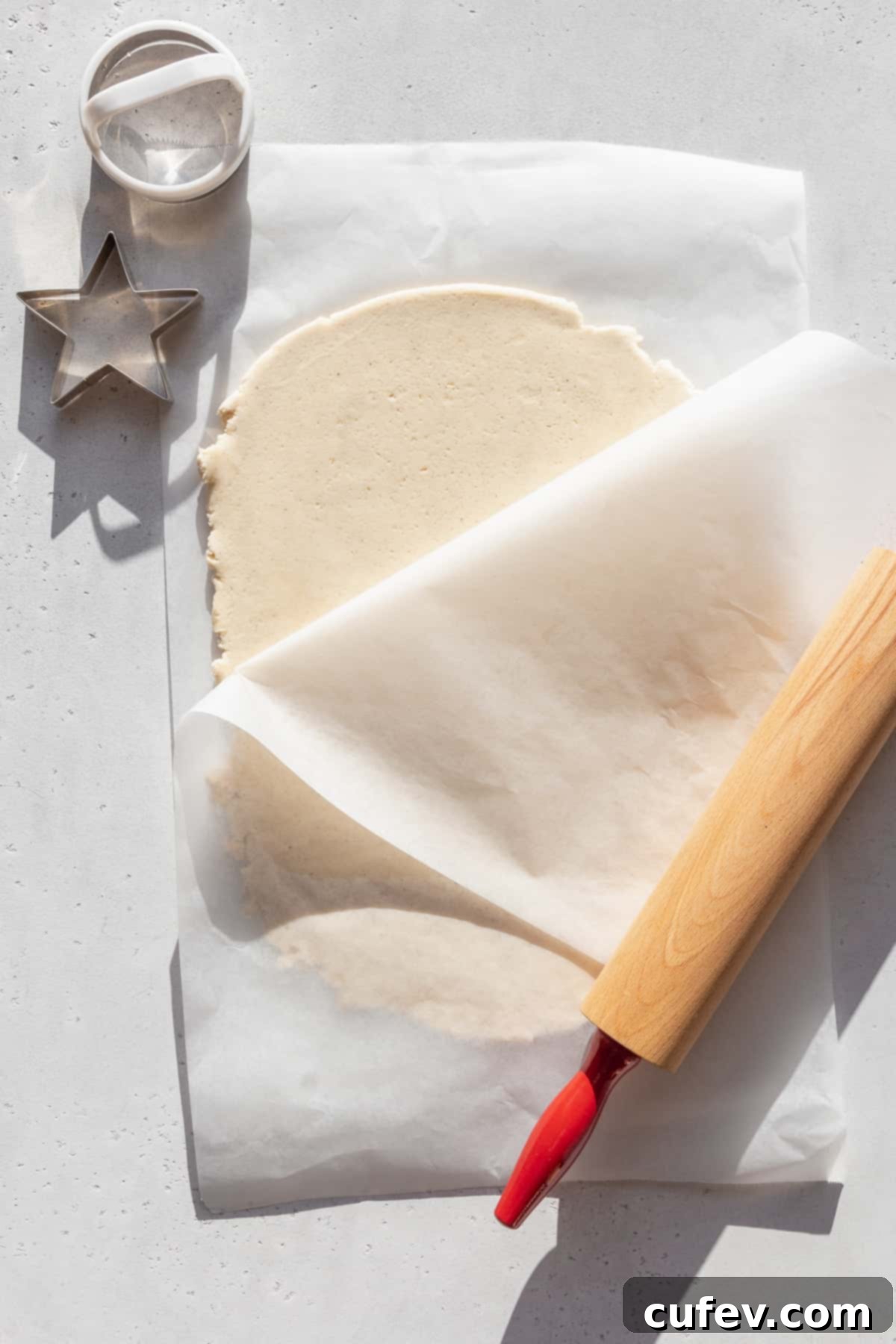
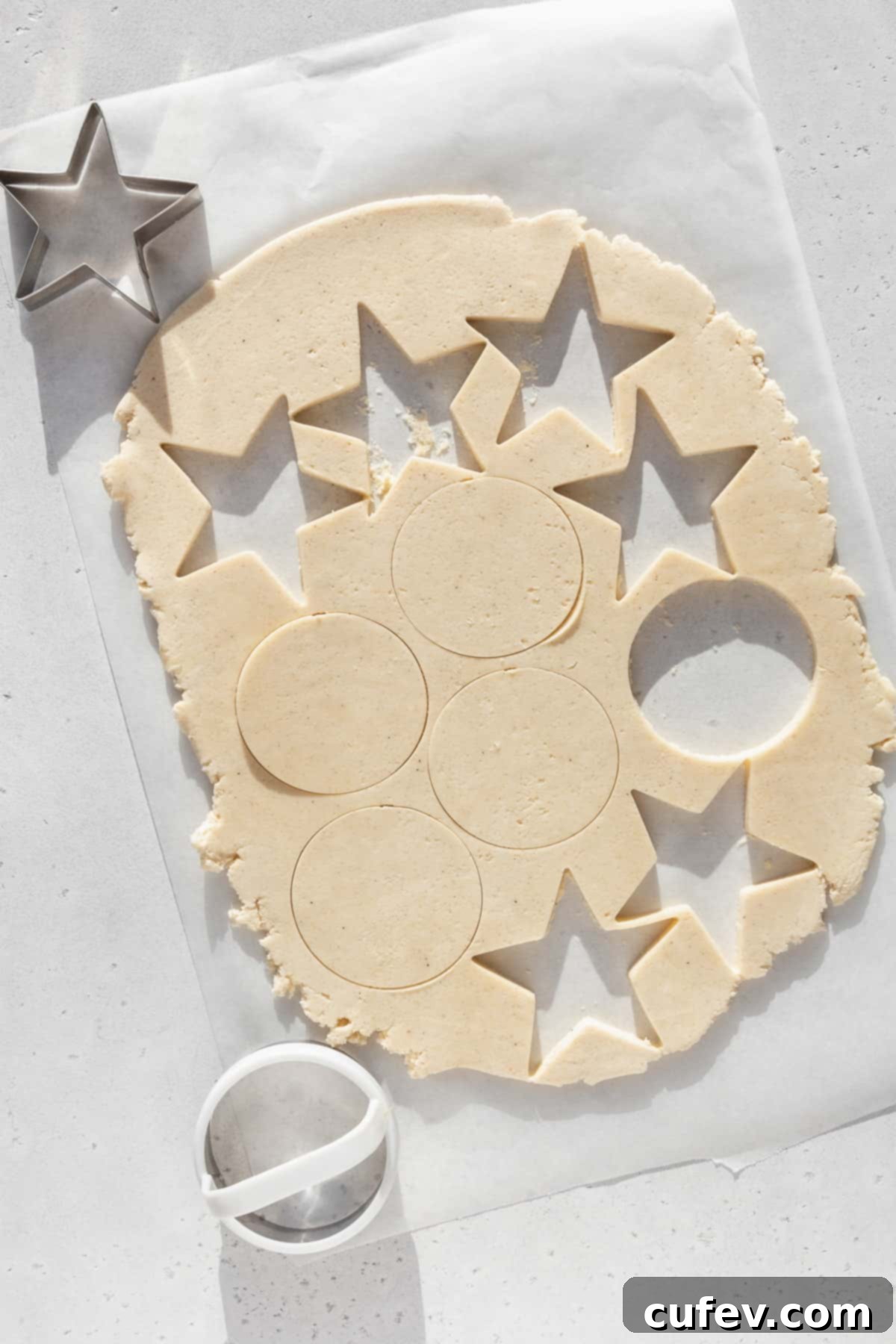
Step 8: Bake to Golden Perfection. Carefully place the gluten-free cookie cutouts onto your parchment-lined baking sheet, leaving a little space between each. Bake for 8-10 minutes. The exact baking time can vary slightly depending on your oven and the size of your cookies. You’ll know they’re ready when the edges just begin to turn a very light golden color. Avoid overbaking, as this can make gluten-free cookies dry and crumbly.
Step 9: Utilize Leftover Dough. Once you’ve cut out the initial batch of cookies, gather the leftover dough scraps. Gently re-roll them between two sheets of parchment paper to the same ¼-inch thickness. Cut out more shapes and continue baking until all your cookie dough is used up. This minimizes waste and maximizes your cookie yield!
Step 10: Cool Completely. After baking, allow the cookies to cool completely on the baking sheet for at least 10-15 minutes before attempting to move them. Gluten-free cookies can be delicate when warm. Once they’ve firmed up on the sheet, carefully transfer them to a wire rack to finish cooling entirely. Complete cooling is essential before decorating to prevent frosting from melting or sliding off.
While these delicious gluten-free sugar cookies are delightful on their own, they are truly elevated with a touch of frosting. You can decorate them with classic royal icing for intricate designs or opt for a rich, creamy buttercream frosting. For your convenience, my favorite easy buttercream frosting recipe is included in the recipe card below, perfect for adding that extra special touch!
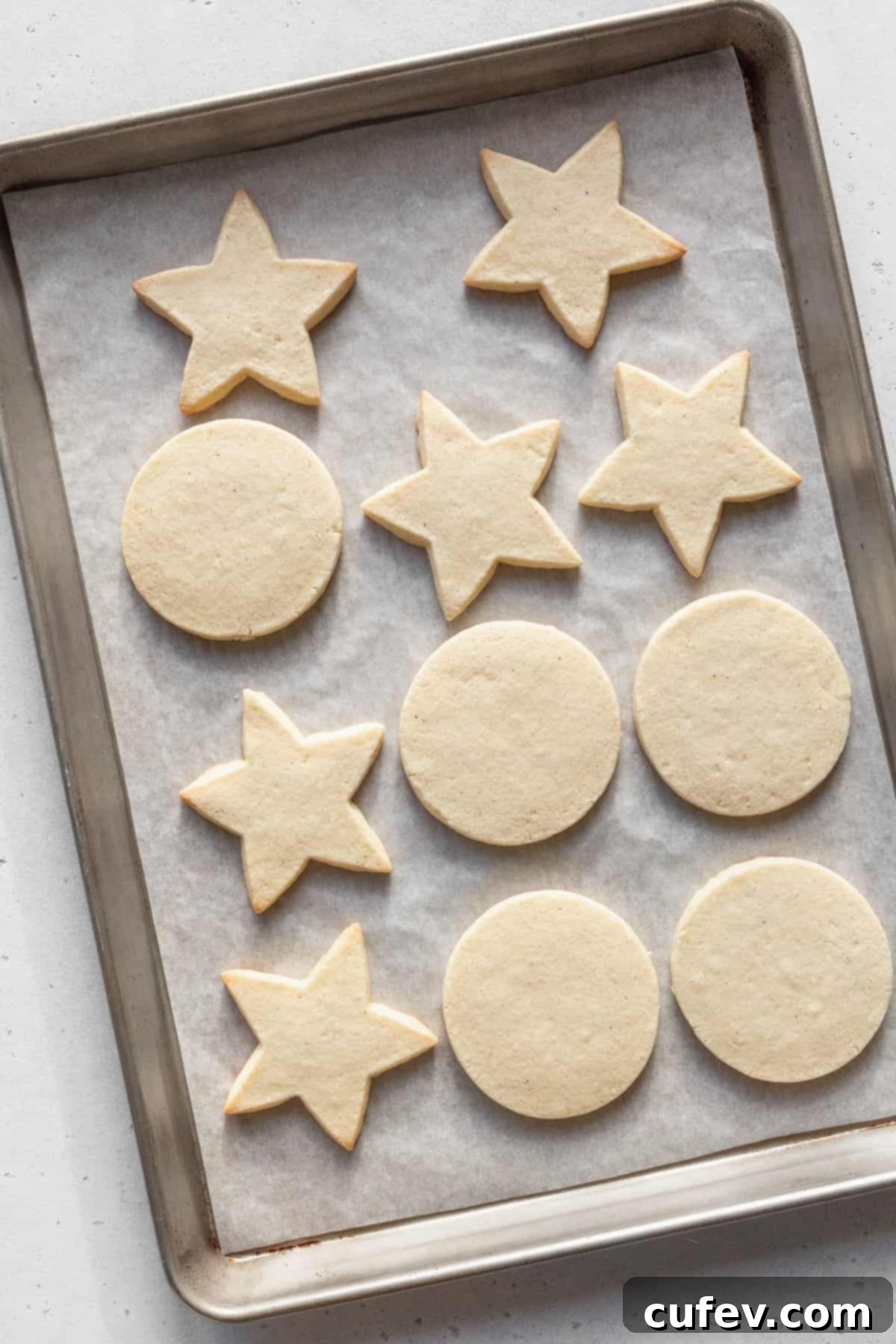
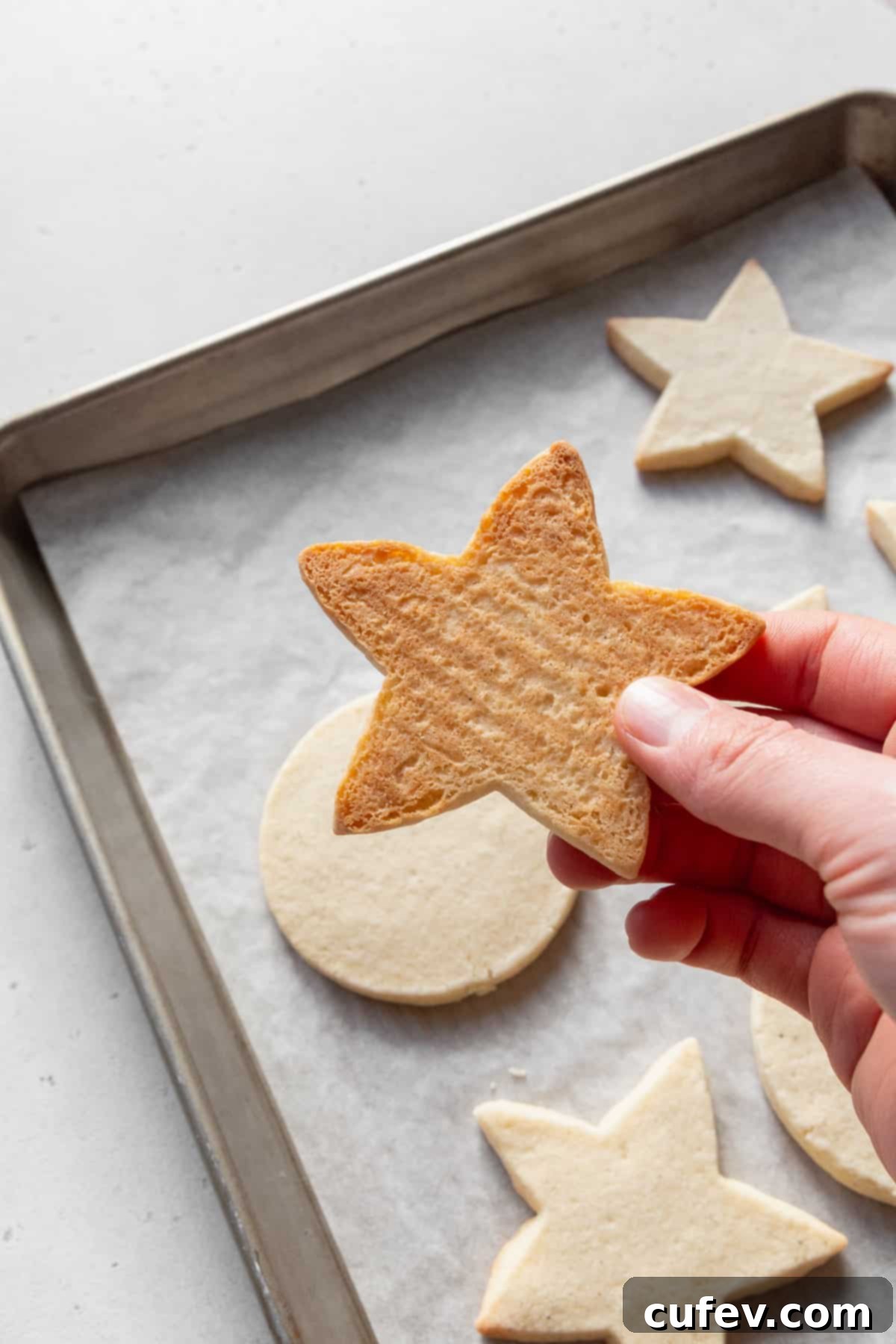
Expert Tips for Gluten-Free Sugar Cookie Success
Achieving bakery-quality gluten-free sugar cookies is easier than you think with these expert tips:
- Don’t Skip the Dough Rest! This is perhaps the most crucial secret to creating truly perfect gluten-free sugar cookies. Allowing the dough to rest for 30 minutes at room temperature before rolling out gives the gluten-free flour blend adequate time to fully hydrate and absorb the liquids. This essential step prevents the cookies from turning out dry, crumbly, or gritty, ensuring they are wonderfully moist, tender, and smooth in texture. It also makes the dough much more pliable and easier to handle when rolling and cutting.
- Adjust Baking Time Based on Cookie Size. Not all cookie cutters are created equal! Larger cookie cutouts will naturally require a slightly longer baking time to cook through evenly, while smaller cookies will bake faster. It’s important to keep a close eye on your cookies as they bake. Look for the edges to just begin turning a very light golden color, rather than waiting for the entire cookie to be golden. This visual cue is your best indicator for doneness, helping you avoid overbaking and ensuring a tender result.
- Always Line Your Baking Sheets. For the best results, always line your baking sheets with either parchment paper or a silicone baking mat. This simple step serves multiple purposes: it helps the cookies bake more evenly by providing a consistent surface, prevents them from sticking to the pan, and makes for effortless removal once baked. Plus, it simplifies cleanup!
- Unleash Your Creativity with Decorating Variations. This easy gluten-free sugar cookie recipe provides a wonderful canvas for your decorating imagination. Personalize your cookies by tinting your frosting or royal icing with a drop or two of food coloring for vibrant hues. Explore a variety of sprinkles, from classic rainbow jimmies to festive sanding sugar, elegant non-pareils, or even edible glitter. You can also experiment with different frosting flavors by adding extracts like almond, lemon, or peppermint for seasonal twists.
- Ensure Ingredients are at Room Temperature. For optimal creaming of butter and sugar, make sure your butter is softened to room temperature (but not melted). Room temperature ingredients emulsify better, leading to a smoother, more uniform dough and a superior cookie texture.
- Measure Flour Accurately. Gluten-free baking is often more precise than traditional baking. The most accurate way to measure flour is by weight using a kitchen scale. If you don’t have one, spoon the flour into your measuring cup and level it off with the straight edge of a knife. Never scoop flour directly from the bag, as this compacts it, leading to too much flour and dry cookies.
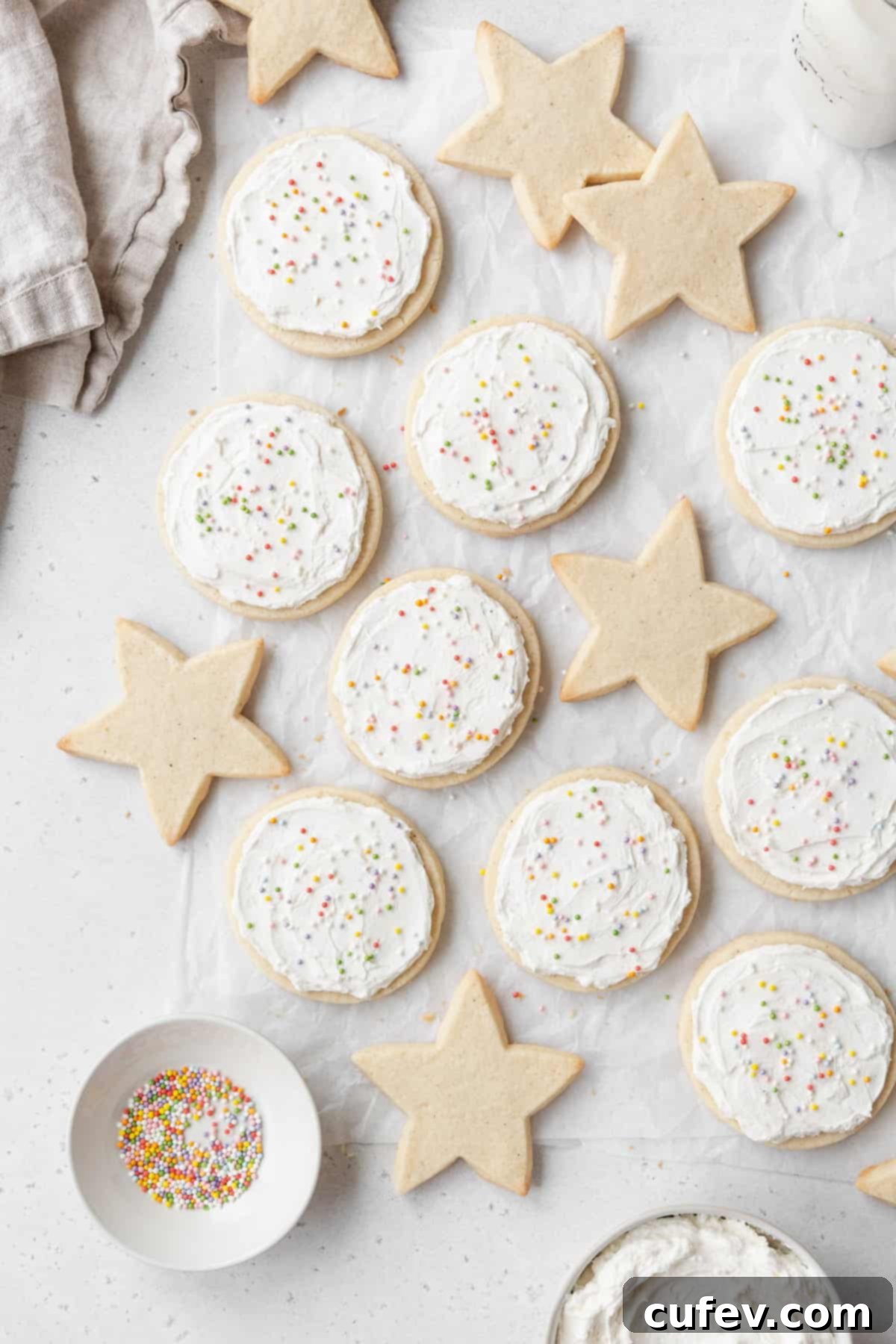
Storing Your Gluten-Free Sugar Cookies
Proper storage ensures your gluten-free sugar cookies remain fresh and delicious for longer. Unfrosted or frosted cookies (with a stable buttercream) can be kept in an airtight container at room temperature for up to 3 days, maintaining their soft texture. To extend their freshness even further, store them in an airtight container in the refrigerator for 4-5 days. If you’ve decorated your cookies with a dairy-free frosting, it’s particularly important to keep them refrigerated to prevent the frosting from becoming too soft or melting at room temperature.
Can You Freeze These Gluten-Free Cookies?
Absolutely! These gluten-free sugar cookies are excellent for freezing, allowing you to enjoy them long after they’re baked. Once any frosting has fully set and hardened, you can carefully layer the frosted gluten-free sugar cookies in a freezer-safe container, separated by parchment paper to prevent sticking. They will keep beautifully for up to 3 months. When you’re ready to enjoy them, simply take them out and let them defrost at room temperature for 10-15 minutes, or until they are thawed through and soft again.
For ultimate convenience, you can also freeze the rolled-out and cut-out cookie dough shapes *before* baking. Arrange the raw cookie cutouts on a parchment-lined baking sheet and freeze until solid. Once frozen, transfer them to a freezer-safe bag or container for up to 3 months. When a craving strikes, you can bake them straight from frozen – just add an extra minute or two to the suggested baking time. This method is perfect for having fresh-baked cookies on demand!
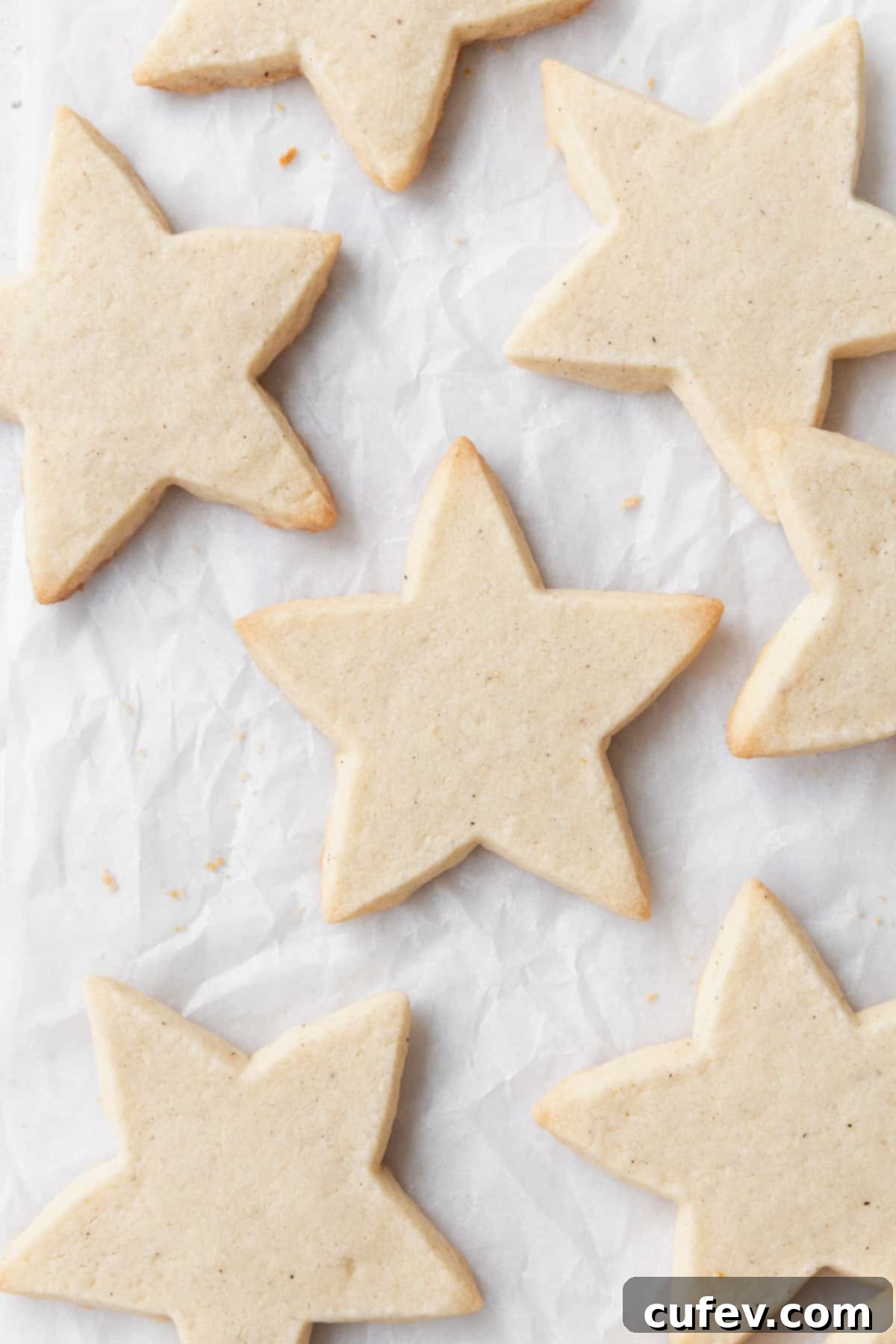
Frequently Asked Questions About Gluten-Free Sugar Cookies
For the best texture and flavor in these sugar cookies, I highly recommend using a high-quality 1-to-1 gluten-free baking flour blend that already contains xanthan gum. My personal go-to is the 1-to-1 baking flour by Bob’s Red Mill. It consistently yields fantastic results. I’ve also had great success with other reliable measure-for-measure flour blends, such as those from King Arthur and Cup4Cup. These blends are formulated to perform similarly to wheat flour, making them ideal for delicate baked goods like sugar cookies.
Yes, absolutely! If you or someone you’re baking for has a nut allergy, or if you simply prefer to omit almond flour, you can easily make these cookies nut-free. Just replace the ½ cup (74g) of almond flour with an additional ½ cup (74g) of the gluten-free 1-to-1 flour blend. The cookies will still be wonderfully tender and delicious, just without the subtle nutty notes from the almond flour.
While it’s technically possible to bake cookies with different types of sugar like brown sugar or coconut sugar, doing so would significantly alter the final outcome of these classic sugar cookies. Brown sugar, with its molasses content, would introduce a chewier texture and a distinct caramel-like flavor, as well as a darker color. Coconut sugar would also change the flavor profile and texture. If you’re out of granulated sugar and need a substitute that will maintain the traditional flavor, texture, and appearance as closely as possible, organic cane sugar would be your best bet, as it has a very similar composition to granulated sugar.
The secret to achieving buttery, tender, and moist gluten-free cookies lies in two key practices. First, always use a high-quality 1-to-1 gluten-free flour blend designed for baking; these blends are formulated to provide better texture. Second, and equally important, is allowing the cookie dough to rest at room temperature before you roll it out. This resting period, typically around 30 minutes, gives the gluten-free flours ample time to hydrate and absorb the moisture from the wet ingredients. This crucial hydration step prevents the final cookies from being dry or crumbly, resulting in a perfectly tender and delightful texture.
Absolutely! If you’re not a fan of almond flavor or need to avoid nuts, feel free to skip the almond extract in the frosting recipe entirely. The frosting will still be wonderfully delicious with just the vanilla extract. If you want to enhance the vanilla flavor even more, you can add a little extra vanilla extract to compensate for the omitted almond extract. The goal is to make the frosting to your personal taste preferences.
For those looking for natural, dye-free options for decorating, there are some fantastic products available. I personally love using the liquid food coloring by Watkins, which uses natural ingredients for vibrant hues. For powdered food coloring that can be mixed into frosting, Suncore powders are an excellent choice. When it comes to dye-free sprinkles, I highly recommend brands like Supernatural and Watkins, which offer a variety of fun and colorful sprinkles made without artificial dyes, perfect for allergy-friendly decorating.
This recipe is designed to yield approximately 24 delicious gluten-free sugar cookies. However, the exact number can vary depending on the size of the cookie cutters you choose to use. If you opt for larger, more elaborate cookie cutters, you will naturally get fewer cookies from the batch. Conversely, using smaller cookie cutters will result in a higher cookie count. Keep this in mind when planning your baking session and adjust expectations accordingly.
No, applesauce cannot be directly substituted for butter in this gluten-free sugar cookie recipe. Butter plays a critical role in providing richness, flavor, and structure, and it’s essential for achieving the tender, crisp-on-the-edges texture of these cookies. Applesauce is a low-fat, high-moisture ingredient that would drastically change the chemical balance of the dough, resulting in cookies with a cake-like texture that would likely be soft all over and lack the desired crispness and buttery taste.
Without a doubt, the most accurate and consistent way to measure flour in any baking recipe, especially gluten-free ones, is by weight using a digital kitchen scale. This eliminates inconsistencies that arise from how tightly flour is packed. If you don’t own a kitchen scale and prefer not to purchase one, the next best method is to “spoon and level.” Gently spoon the flour into your measuring cup until it overflows, then use the flat side of a knife or another straight edge to level off the excess flour, without packing it down. Avoid scooping directly with the measuring cup, as this can compact the flour and result in using too much, leading to dry and dense cookies.
To make these delicious gluten-free sugar cookies, you’ll need some basic kitchen equipment: a large mixing bowl (or a stand mixer with a paddle attachment), a separate medium bowl for dry ingredients, a whisk, a rubber spatula, a rolling pin, two sheets of parchment paper, various cookie cutters, baking sheets, and a wire cooling rack. A kitchen scale is highly recommended for accurate flour measurement, but optional if you’re careful with the spoon and level method.
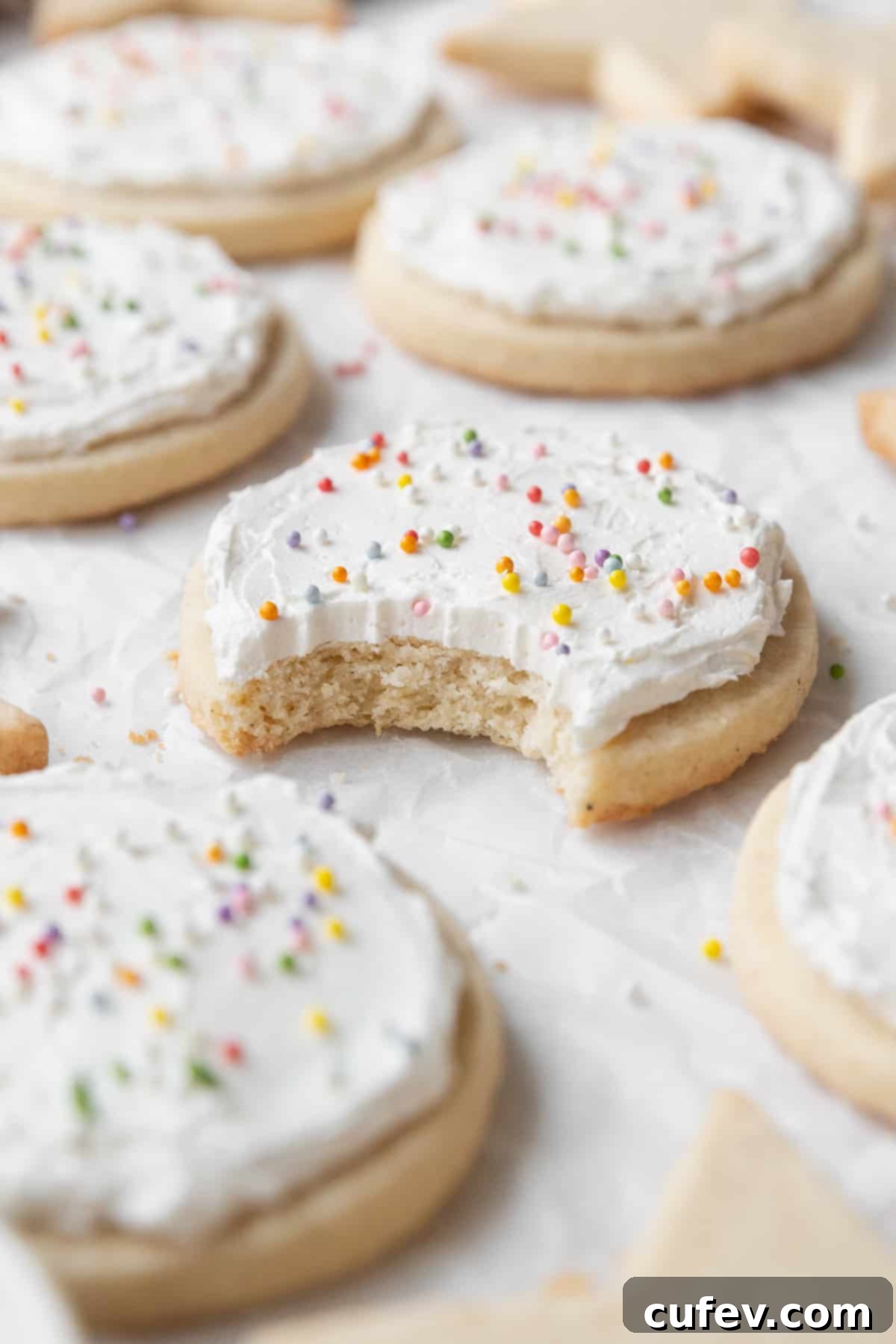
More Delightful Gluten-Free Cookie Recipes You’ll Love
If you enjoyed making these gluten-free sugar cookies, you might want to explore more delicious and allergy-friendly cookie creations:
- If you adore a sweet, jam-filled treat, try my gluten-free thumbprint cookies! These are not only gluten-free but also completely vegan, making them a fantastic option for a wider range of dietary needs.
- For the ultimate classic, these gluten-free dairy-free chocolate chip cookies are my absolute favorite. They boast perfectly crisp edges combined with delightfully fudgy and chewy centers – truly the best of both worlds!
- Elevate your cookie game with these exquisite vegan lemon curd cookies. They feature a rich, buttery sugar cookie base, artfully filled with bright and silky homemade lemon curd, offering a burst of zesty flavor.
- Are you a fellow chocoholic who can’t get enough? Then you absolutely must try these decadent gluten-free double chocolate chip cookies! They are rich, fudgy, and intensely satisfying for any chocolate craving.
Thanks so much for stopping by! I sincerely hope you loved this gluten-free sugar cookie recipe as much as I do. For more mouth-watering dairy-free, gluten-free, and/or vegan dessert inspiration, make sure to follow me on Pinterest, Facebook, and Instagram. You can also get all of my newest content delivered straight to your inbox by signing up for my email newsletter — I promise not to spam you!

Gluten-Free Sugar Cookie Recipe
Dessert, Snack
American
15 minutes
10 minutes
2 hours
2 hours
25 minutes
24
cookies
139
kcal
Ai Willis
Print
Pin
Rate
Ingredients
Sugar Cookies
-
2
cups
gluten-free 1-to-1 flour -
½
cup
almond flour -
½
teaspoon
fine salt -
1
cup
butter
regular or dairy-free -
⅔
cup
granulated sugar -
1
tablespoon
milk
regular or dairy-free -
1½
teaspoons
vanilla extract
Cookie Frosting (Optional)
-
½
cup
butter
regular or dairy-free -
1⅔
cups
powdered sugar -
¼
teaspoon
vanilla extract -
¼
teaspoon
almond extract -
1
tablespoon
milk
regular or dairy-free -
sprinkles
optional
Instructions
Sugar Cookies
-
Whisk the gluten-free flour blend, almond flour, and salt together in a mixing bowl.
-
In a separate bowl with a hand mixer or in the bowl of a stand mixer fitted with a paddle attachment, cream the softened butter and granulated sugar together until light and fluffy, about 3 minutes. Add the milk and vanilla extract and beat again until combined.
-
Add the flour mixture to the butter mixture and mix until no streaks of flour remain. Cover the dough and let it rest on the counter for 30 minutes.
-
Turn the dough out onto a piece of parchment paper. Cover it with another sheet of parchment paper and roll it out to ¼ inch (½ cm) thickness. Put the sheet of rolled out dough into the refrigerator while you preheat the oven.
-
Preheat the oven to 375°F (190°C) and line a baking sheet with parchment paper.
-
Take the chilled rolled-out cookie dough out of the refrigerator and cut out shapes using cookie cutters. Put the cutouts on the parchment-lined baking sheet and bake for 8-10 minutes.
-
Re-roll any leftover cookie dough and bake more cookies, until you have no more cookie dough left.
-
Cool the cookies completely on the baking sheet before moving them onto a wire rack.
Cookie Frosting
-
In a bowl, beat the butter until light and fluffy, about 3 minutes.
-
Add half of the powdered sugar and beat until the mixture is creamy. Scrape the bowl with a spatula and beat in the remainder of the powdered sugar.
-
Beat in the vanilla and almond extract, and milk. Scrape the bowl again to make sure there aren’t any hidden pockets of powdered sugar.
-
Put as much or little frosting as you like on each cooled cookie, and top with sprinkles.
Notes
Storage: Leftover cookies keep in an airtight container at room temperature for up to 3 days. Keep them fresh longer by storing them in the refrigerator for 4-5 days. If using a dairy-free frosting to decorate, keep these cookies in the refrigerator to prevent the frosting from melting at room temperature.
Freezing: These cookies can be frozen in a freezer-safe container for up to 3 months. Defrost them at room temperature for 10-15 minutes, or until thawed through. You can also freeze cut out cookie dough shapes so they’re ready to be baked straight out of the oven. You may need an extra minute in the oven.
Adjust the baking time for the size of the cookie cutters. You may need to add additional baking time for larger cookie cutouts and reduce the baking time for smaller cookies. Keep an eye on the cookies as they bake and adjust the baking time as needed.
Love this recipe?
Snap a photo and share tagging @aimadeitforyou or tag #aimadeitforyou!
Nutrition
